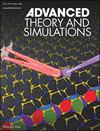β-亚硝基苯乙烯合成α-氰膦酸盐可能机理的DFT研究
IF 2.9
4区 工程技术
Q1 MULTIDISCIPLINARY SCIENCES
引用次数: 0
摘要
本文从理论上研究了三苯基亚磷酸酯加成β-硝基苯乙烯的反应机理。M062X方法是密度泛函理论(DFT)的一个子集,def2svp基集用于确定合适的机制。提出了三种可能的机制途径,标记为途径A, B和C。在途径A中,在β-硝基苯乙烯的β-位置上加入亚磷酸三苯酯。途径B涉及到将亚磷酸三苯分子加成到β-硝基苯乙烯中硝基的氧上。在途径C中,在β-硝基苯乙烯化合物的氮中加入亚磷酸三苯酯。由于该反应需要两mmol的亚磷酸三苯酯的存在才能形成所需的产物,因此所提出的机制的所有三条路线都被相应地设计。在气相中,路径A和路径B的总能垒分别为19.31和43.47 kcal mol−1,而路径c没有得到可靠的过渡态。在不同溶剂中,路径A在水、甲醇和二甲基甲酰胺中的总能垒分别为20.75、20.76和20.76 kcal mol−1。因此,路径A是更有利的路径,气相和不同溶剂的结果没有显著差异。本文章由计算机程序翻译,如有差异,请以英文原文为准。

DFT Study of the Possible Mechanisms for Synthesizing α-Cyanophosphonates from β-Nitrostyrenes
In this report, the reaction mechanism of triphenylphosphite addition to β-nitrostyrene is theoretically investigated. The M062X method, a subset of density functional theory (DFT), and the def2svp basis set are used to determine the appropriate mechanism. Three plausible mechanistic routes, labeled pathways A, B, and C, are proposed. In pathway A, triphenyl phosphite is added to the β-position of β-nitrostyrene. Pathway B involves the addition of the triphenyl phosphite molecule to the oxygen of the nitro group in β-nitrostyrene. In pathway C, triphenyl phosphite is added to the nitrogen of the β-nitrostyrene compound. Since the reaction requires the presence of two mmol of triphenyl phosphite to form the desired product, all three routes of the proposed mechanism are designed accordingly. In the gas phase, the overall energy barriers of paths A and B are 19.31 and 43.47 kcal mol−1, respectively, while no reliable transition state is obtained for path C. For path A in different solvents, the overall energy barriers are 20.75, 20.76, and 20.76 kcal mol−1, respectively in water, methanol, and dimethylformamide. Therefore, path A is a more favorable path, and there is not a meaningful difference between the results of the gas phase and different solvents.
求助全文
通过发布文献求助,成功后即可免费获取论文全文。
去求助
来源期刊

Advanced Theory and Simulations
Multidisciplinary-Multidisciplinary
CiteScore
5.50
自引率
3.00%
发文量
221
期刊介绍:
Advanced Theory and Simulations is an interdisciplinary, international, English-language journal that publishes high-quality scientific results focusing on the development and application of theoretical methods, modeling and simulation approaches in all natural science and medicine areas, including:
materials, chemistry, condensed matter physics
engineering, energy
life science, biology, medicine
atmospheric/environmental science, climate science
planetary science, astronomy, cosmology
method development, numerical methods, statistics
 求助内容:
求助内容: 应助结果提醒方式:
应助结果提醒方式:


